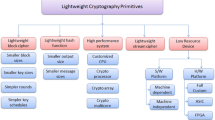Abstract
Currently, there are some defects in data aggregation encryption methods, such as low accuracy and efficiency. In this regard, this paper proposes an aggregation encryption method of social network privacy data based on matrix decomposition. Shamir threshold segmentation scheme was used to improve the security of matrix decomposition results, and then re-encrypted network user attributes. For codomain and non-codomain users, private file and key generation technology were used to improve the privacy of users in common domain and non-common domain. Considering the results of matrix decomposition, privacy security and efficient user matching in social networks were implemented. The node information was embedded in the process of data encryption and signature, and the interference factors were classified by cluster as a unit, which can resist the internal attack and improve the operation efficiency. The experimental results show that this method has excellent encryption effect and high privacy data protection processing efficiency.







Similar content being viewed by others
Data Availability
There is no data file included in this work.
Code Availability
There is no specific code in this work specified.
References
Shen, P. H., Qi, Y. H., Yu, W., & Li, F. H. (2018). Inverse matrix auto-search technique for the RTS MIMO OTA test—Part II: validations. IEEE Transactions on Electromagnetic Compatibility, 60(5), 1288–1295.
Zhu, L. H., Tang, X. Y., Shen, M., Du, X. J., & Guizani, M. (2018). Privacy-preserving DDoS attack detection using cross-domain traffic in software defined networks. IEEE Journal on Selected Areas in Communications, 36(3), 628–643.
Chen, B. W., Wu, L. B., Wang, H. Q., Zhou, L., & He, D. B. (2020). A blockchain-based searchable public-key encryption with forward and backward privacy for cloud-assisted vehicular social networks. IEEE Transactions on Vehicular Technology, 69(6), 5813–5825.
Jiao, H. S., Pu, T., Zheng, J. L., Zhou, H., Lu, L., Xiang, P., et al. (2018). Semi-quantum noise randomized data encryption based on an amplified spontaneous emission light source. Optics Express, 26(9), 11587.
Hassan, D., Redif, S., & Lambotharan, S. (2019). Polynomial matrix decompositions and semi-blind channel estimation for MIMO frequency-selective channels. IET Signal Processing, 13(3), 356–366.
Hong, J. J., Liu, B., Sun, Q. Y., & Li, F. G. (2019). A combined public-key scheme in the case of attribute-based for wireless body area networks. Wireless Networks, 25(2), 845–859.
Zhang, L., Kim, K. T., & Bathe, K. J. (2018). The new paradigm of finite element solutions with overlapping elements in CAD—Computational efficiency of the procedure. Computers & Structures, 199(4), 1–17.
Trushechkin, A. S. (2020). Operational meaning and practical aspects of the use of the security parameter in the quantum key distribution. Quantum Electronics, 50(5), 426–439.
Bokhari, M. U., Shallal, Q. M., & Tamandani, Y. K. (2019). Reducing the required time and power for data encryption and decryption using K-NN machine learning. IETE Journal of Research, 65(2), 227–235.
Cao, L. C., Kang, Y. F., Wu, Q. R., Wu, R., & Tao, F. (2020). Searchable encryption cloud storage with dynamic data update to support efficient policy hiding. China Communications, 17(6), 153–163.
Padhya, M., & Jinwala, D. C. (2019). MULKASE: A novel approach for key-aggregate searchable encryption for multi-owner data. Frontiers of Information Technology & Electronic Engineering, 20(12), 1717–1748.
Kim, J., & Vetter, J. S. (2019). Implementing efficient data compression and encryption in a persistent key-value store for HPC. Experimental Mechanics, 33(6), 1098–1112.
Wei, J. H., Huang, X. Y., Liu, W. F., & Hu, X. X. (2018). Cost-effective and scalable data sharing in cloud storage using hierarchical attribute-based encryption with forward security. International Journal of Foundations of Computer Science, 28(07), 843–868.
Vijayakumar, V., Priyan, M. K., Ushadevi, G., Varatharajan, R., Manogaran, G., & Tarare, P. V. (2019). E-Health cloud security using timing enabled proxy re-encryption. Mobile Networks & Applications, 24(3), 1034–1045.
Wen, Z. (2020). Research on revoidable encryption simulation of ontology storage data in Internet of Things. Computer Simulation, 037(004), 322–325.
Funding
There is no funding provided.
Author information
Authors and Affiliations
Corresponding author
Ethics declarations
Conflict of interest
There is no conflict of interest.
Additional information
Publisher's Note
Springer Nature remains neutral with regard to jurisdictional claims in published maps and institutional affiliations.
Rights and permissions
About this article
Cite this article
Bi, H. Aggregation Encryption Method of Social Network Privacy Data Based on Matrix Decomposition Algorithm. Wireless Pers Commun 127, 369–383 (2022). https://doi.org/10.1007/s11277-021-08268-8
Accepted:
Published:
Issue Date:
DOI: https://doi.org/10.1007/s11277-021-08268-8




